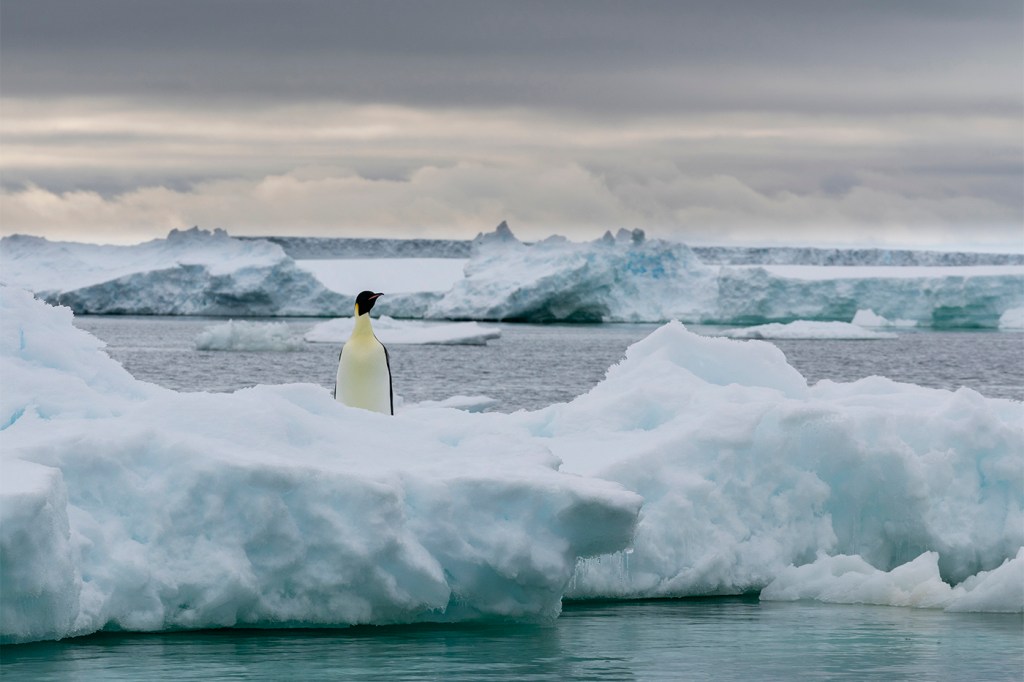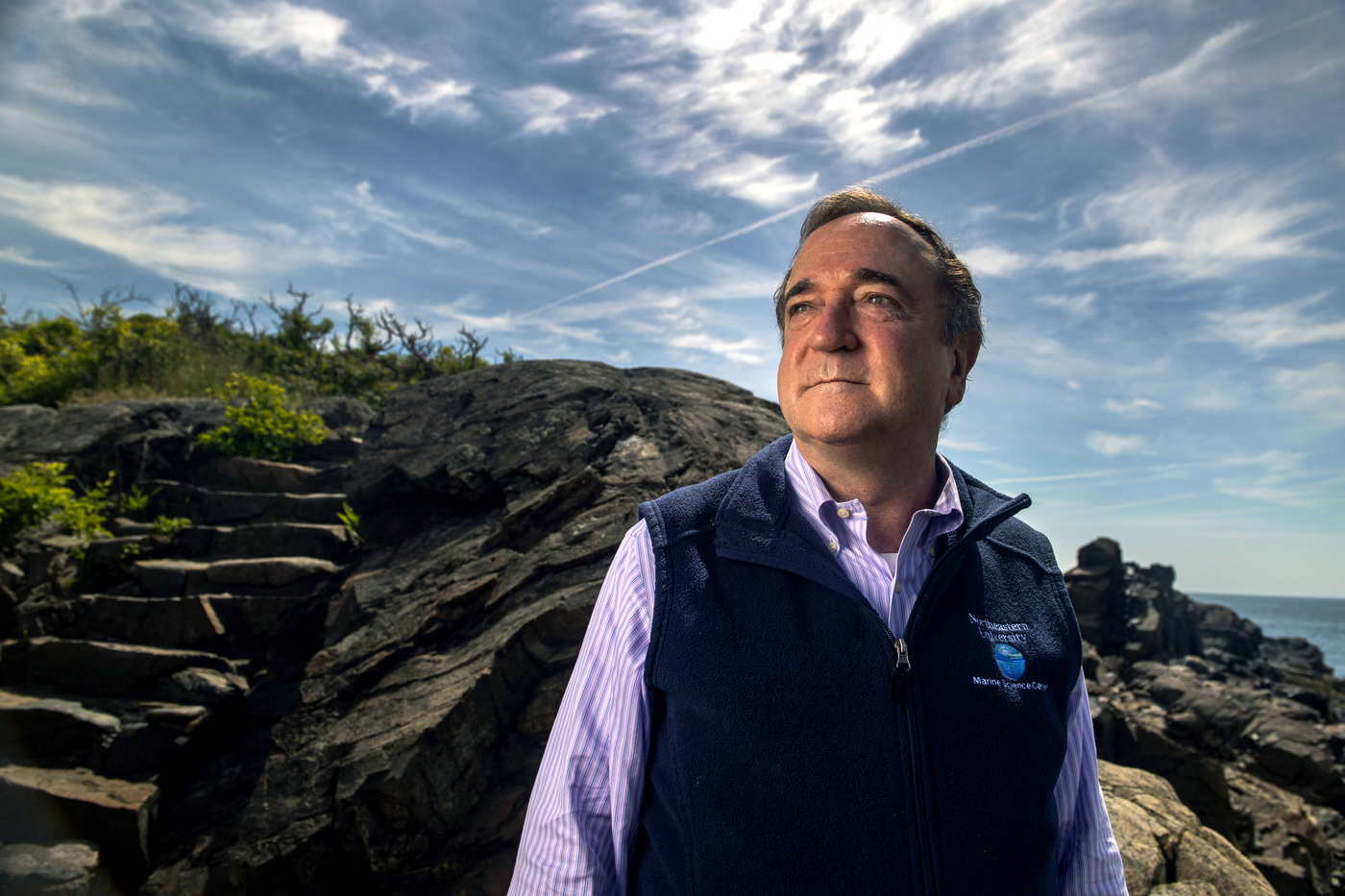Emperor penguins are Antarctica’s most iconic bird. Are they on the verge of extinction?

Think of Antarctica and you probably conjure images of the emperor penguin.
The iconic bird, known for gold markings on the sides of its neck, is the darling of polar south nature videos and is the species represented by most of the penguin characters in the animated film series “Happy Feet.”
But last year, the emperor penguin’s breeding season was an almost total failure in a region off the west coast of Antarctica, as reported in the Aug. 24 issue of Nature’s “Communications Earth & Environment.”
The report says satellite imagery suggests that no chicks in four out of five known colonies in the Bellinghausen Sea appear to have survived in 2022 due to the loss of sea ice before they had time to develop their waterproof feathers.

The loss “is tied to the severe lack of winter sea ice this year,” says H. William Detrich, professor emeritus at Northeastern’s Marine Science Center and a veteran Antarctic researcher.
What happened?
“The life cycle of emperor penguins is strongly tied to environmental conditions, such as the presence of sea ice in winter,” Detrich says.
Emperor penguins arrive at breeding sites in late March and April and lay eggs from May to June.
Eggs hatch after 65 days, but the chicks don’t start fledging and developing waterproof feathers until December and January — meaning the sea ice must remain stable from April to January to ensure their survival, according to the Nature article.
Instead the sea ice started breaking up in November, which researchers say doomed the fluffy chicks and led their parents to abandon colonies.
“This is the first recorded incident of a widespread breeding failure of emperor penguins that is clearly linked with large-scale contractions in sea ice extent,” researchers said.
Do emperor penguins have a chance?
The continent of Antarctica and its ocean may be some of the coldest places on Earth, but they are also warming faster than any other place on the planet, Detrich says.
“Sea ice formation is connected to climate change in complicated ways,” he says. “Future years of continued low sea ice conditions would have a serious impact on emperor population sizes.”
“However, it is likely that there will be ‘refugia,’ areas around the continent that have sufficient winter sea ice to sustain local populations of emperors.”
Off the east coast of Antarctica, tourists regularly visit Snow Hill Island to view emperor colonies. “There are major emperor colonies in Eastern Antarctica, including near McMurdo Station,” Detrich says.
“I don’t think this is ‘Emperor Doomsday,’” he says. “It is important to note that penguin breeding colony success has collapsed occasionally in the past, but these events were followed by successful breeding in subsequent years.”
“It all comes down to climate variability in the Antarctic,” Detrich says. “And climate change is causing the Antarctic climate to become increasingly variable and unpredictable.”
This is the first recorded incident of a widespread breeding failure of emperor penguins that is clearly linked with large-scale contractions in sea ice extent.
H. William Detrich, professor emeritus at Northeastern’s Marine Science Center and a veteran Antarctic researcher
The Nature article says concentrations of Antarctic sea ice reached the lowest levels ever observed in 2021-22 and 2022-23.
Researchers said the weakening of the La Niña weather phenomenon could lead to the growth of more sea ice in the Bellingshausen Sea, but they fear that the emperor penguin colony collapses “may represent a snapshot of a future, warming Antarctica.”
What happened to other penguin species
Emperor penguins, which can grow to the height of a first grade child, are particularly at risk due to their dependence on winter sea ice, Detrich says.
A specialist in Antarctic marine species, Detrich supports the establishment of an Antarctic biorepository to make sure that any serious researcher who wants to study the birds, animals, plants and microorganisms of the polar south gets a chance to do so.
He says his knowledge of penguins come mainly from following the work of fellow scientist William Fraser, whom he knows from his time doing research at Palmer Station in Antarctica.
Among species that Fraser studied starting in the 1970s were Adelie penguins, a sea ice dependent penguin known to collect pebbles to build their nests — the Amigos in “Happy Feet.”
“As time progressed, sea ice became scarcer around Palmer, and the local Adelie population entered a long-term decline,” Detrich says. “They were replaced by sub-Antarctic species — Gentoos and Chinstraps — that are not dependent on sea ice. So, Adelies are down in this area, whereas other species are thriving.”
Expedition Antarctica
Detrich’s own expeditions to Antarctica, which started in 1981, typically lasted from two to three months due to both the demands of his research and the limited window of time in which to travel by ship across unfrozen seas to his main base at Palmer Station.
In 2016, a spot of land within a mile of Palmer Station was named Detrich Island in honor of the professor, who retired from Northeastern in December 2021 and donated samples of rare Antarctic fish to Northeastern’s Ocean Genome Legacy Center.
Emperor penguins may be the most visible symbol of Antarctica, but most of the continent’s biodiversity consists of marine life, Detrich says.
Rapidly warming conditions mean the clock is ticking on ecosystem change in the Southern Ocean, he says.
“We need research to predict what kind of changes will occur to the biology of the Antarctic ecosystem and to determine what steps we can take to mitigate deleterious effects on the resident life.”
Cynthia McCormick Hibbert is a Northeastern Global News reporter. Email her at c.hibbert@northeastern.edu or contact her on Twitter @HibbertCynthia






